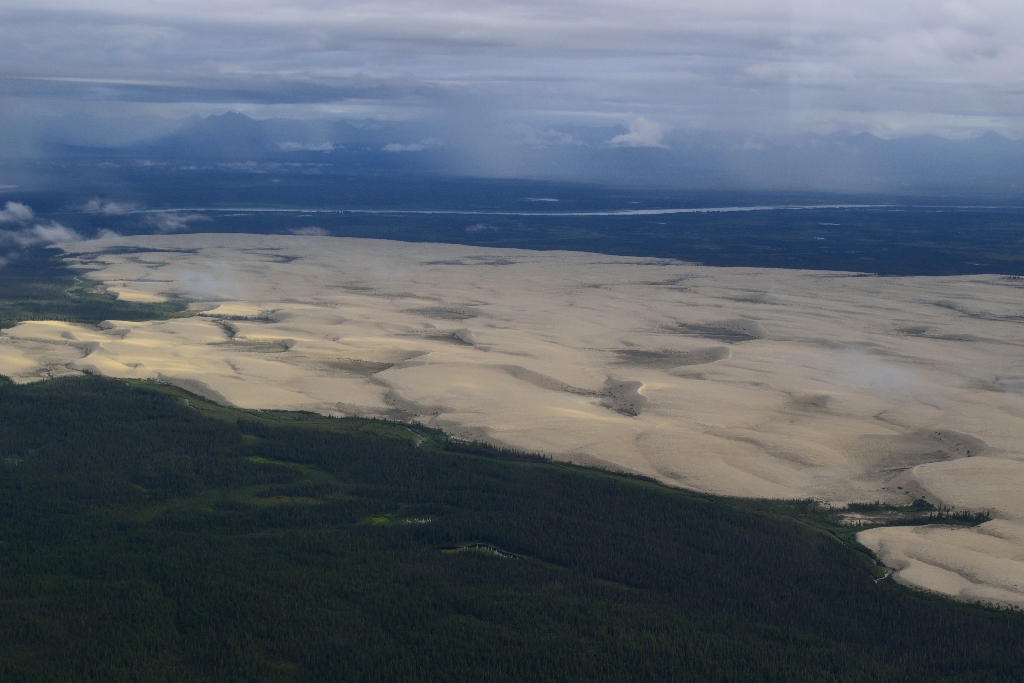
The Great Kobuk Sand Dunes are easy to spot from the sky. A large tan patch in the middle of a sea of green trees and blue water ways. But how did they get there?
While no glaciers currently exist within the park, two earlier glaciations, the Kobuk and Ambler glaciations, covered large areas of the Kobuk and Selawik valleys, as well as the drainages of the Baird Mountains.
During the interglacial period between the Kobuk and Ambler glaciations, sediments (glacio-fluvial deposits) left behind on river bars and outwash plains were worn down by strong easterly winds. The down-valley movement of large volumes of silt and sand created dune fields, which cover an area of approximately 200,000 acres. Most of this dune area is currently vegetated by tundra and forest, except for the three active dune fields - the Great Kobuk Sand Dunes, the Little Kobuk Sand Dunes and the Hunt River Dunes. These active dunes cover approximately 20,500 acres.
The Great Kobuk Sand Dunes’ field displays a complete sequence of dune development. They range from the eastern U-shaped, concave dunes with vegetation, to the western crescent-shaped, unvegetated barchan dunes, which stand over 100 feet in height. It is the largest active dune field in arctic North America.
The Great Kobuk Sand Dunes are a popular destination for hiking and camping. Aircraft on wheels can land right on the sand. Tents can be set up on any level surface and day hiking in any direction is feasible. An alternative is to land on the Kobuk River in a float plane and backpack two miles across the tundra up to the dunes. Getting there is an orienteering exercise that takes about 4 hours round trip, not including time to enjoy the dunes themselves, even for the most experienced hikers.
Depending on the time of year, visitors could have some amazing experiences with the natural world. From hiking on the dunes in the summer and experiencing 100 degree Fahrenheit weather above the Arctic Circle to observing the caribou migration in the fall, these sand dunes are truly a special place.
While no glaciers currently exist within the park, two earlier glaciations, the Kobuk and Ambler glaciations, covered large areas of the Kobuk and Selawik valleys, as well as the drainages of the Baird Mountains.
During the interglacial period between the Kobuk and Ambler glaciations, sediments (glacio-fluvial deposits) left behind on river bars and outwash plains were worn down by strong easterly winds. The down-valley movement of large volumes of silt and sand created dune fields, which cover an area of approximately 200,000 acres. Most of this dune area is currently vegetated by tundra and forest, except for the three active dune fields - the Great Kobuk Sand Dunes, the Little Kobuk Sand Dunes and the Hunt River Dunes. These active dunes cover approximately 20,500 acres.
The Great Kobuk Sand Dunes’ field displays a complete sequence of dune development. They range from the eastern U-shaped, concave dunes with vegetation, to the western crescent-shaped, unvegetated barchan dunes, which stand over 100 feet in height. It is the largest active dune field in arctic North America.
The Great Kobuk Sand Dunes are a popular destination for hiking and camping. Aircraft on wheels can land right on the sand. Tents can be set up on any level surface and day hiking in any direction is feasible. An alternative is to land on the Kobuk River in a float plane and backpack two miles across the tundra up to the dunes. Getting there is an orienteering exercise that takes about 4 hours round trip, not including time to enjoy the dunes themselves, even for the most experienced hikers.
Depending on the time of year, visitors could have some amazing experiences with the natural world. From hiking on the dunes in the summer and experiencing 100 degree Fahrenheit weather above the Arctic Circle to observing the caribou migration in the fall, these sand dunes are truly a special place.
Is there something we missed for this itinerary?
Itineraries across USA

Acadia

Arches National Park

Badlands

Big Bend

Biscayne

Black Canyon Of The Gunnison

Bryce Canyon

Canyonlands

Capitol Reef

Carlsbad Caverns

Channel Islands

Congaree

Crater Lake

Cuyahoga Valley

Death Valley

Dry Tortugas

Everglades

Gateway Arch

Glacier

Grand Canyon

Grand Teton

Great Basin

Great Smoky Mountains

Guadalupe Mountains

Haleakalā

Hawaiʻi Volcanoes

Hot Springs

Indiana Dunes

Isle Royale

Joshua Tree

Kenai Fjords

Kobuk Valley

Lassen Volcanic

Mammoth Cave

Mesa Verde

Mount Rainier

North Cascades

Olympic

Petrified Forest

Pinnacles

Rocky Mountain

Saguaro

Shenandoah

Theodore Roosevelt

Virgin Islands

Voyageurs

White Sands

Wind Cave

Yellowstone

Yosemite

Zion